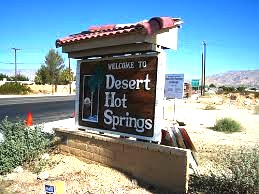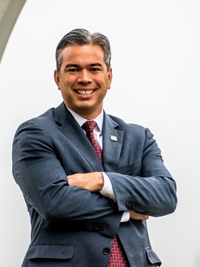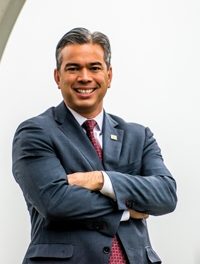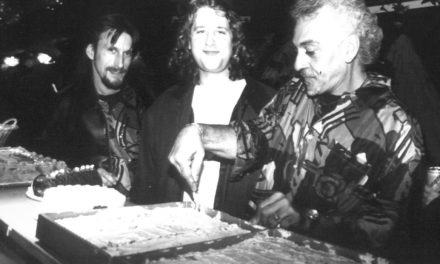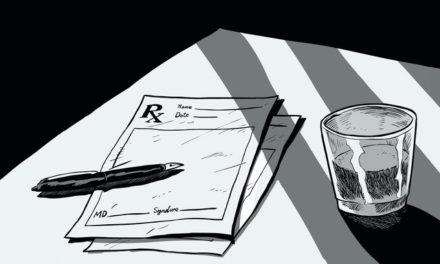By Paul Krassner March 12, 2014
I live in Desert Hot Springs, CA., just adjacent to the way more famous Palm Springs, and a short ride to the Yucca Valley and the beloved-by-many Joshua Tree National Park. This is the desert, and life out here for a medical marijuana patient like myself (I walk with a walker and have serious pain issues that I will not risk addiction to handle by taking opioid pain killers) and for the MM community here is like living in a different movie than you might imagine. Sometimes it’s like a science fantasy movie.
Here is an example: When it came time for me to renew my annual medical marijuana recommendation from a licensed physician, I was required to go his office. I showed up in person, but he arrived by the grace of Skype. There he was – that is to say, there was an image of him on a computer screen.
Sitting at a desk in another city, wearing earphones with a little microphone attached, he was waiting for me. So I sat down at my desk and put on a similar headset. As he already had my previous medical records, we then went through the motions of discussing my health, followed by what seemed to be an infomercial during which he delineated all the edibles and other vehicles for cannabis available to me.
Standing to the side was my wife Nancy, who took a photo of this strange interaction in cyberspace. She could only hear what I was saying and had no idea that when the doctor finished with me, he said, “Now may I speak with the lady?” Nancy only heard me reply “that’s my wife—she doesn’t smoke,” which I uttered with the knowledge that it would be technically illegal if I shared my stash with her.
I handed her the headset and said, “The doctor wants to speak with you.”
“Hi,” she said.
Later, she informed me of their brief dialogue: “The doctor says, ‘I am told you are taking pictures.’ Who would have told him? He could obviously see me in the wide-angle picture on his Skype. I had only taken one picture, as a small remembrance. ‘I took one picture,’ I said to the doctor. ‘Is that wrong?’ I thought that maybe no pictures were allowed. I always like to take pictures where they are not allowed, but apparently it wasn’t an issue.”
Ironically, instead of answering her question, the doctor said, “If you have any questions, please ask me.”
“I have no questions,” she replied.
“Well, if you ever have any, ask me.”
“Okay.”
Then we left for a dispensary that sends out emails of daily specials, describing different strains of marijuana with poetic grace. Here’s a sample: “Raspberry OG Kush is a great-tasting indica strain. This strain will lead to a bit of a body melt, but it can be surprisingly upbeat for an indica. It may leave newer patients feeling pretty lazy, but many find this kush to be a creative flower, making it great for music, art or talking with friends. Its genetics are unknown, but it is possibly the love-child of Raspberry Cough and Cheese.”
The receptionist at the dispensary shared a little technological tale: “One guy brought back his electronic vapor pen because he couldn’t get it to work. The ‘budtender’ asked him to show her how he was using it. He lit a lighter and held it to the end of it. I thought that was funny.”
AND THEN THERE’S BIG BROTHER GOVERNMENT
So much for now for the absurdity side of the science fantasy of obtaining medical marijuana in the desert. What Lanny Swerdlow experienced wasn’t funny at all. His science fantasy movie was about the bad Big Brother government trying to control all human behavior and telling whatever lies it needed to for public consumption.
Lanny is a registered nurse. He hosts an award-winning radio program, Marijuana Compassion and Common Sense, and he is president of the Inland Empire Chapter of the Marijuana Anti-Prohibition Project, a medical patient support group and law reform organization. A diligent activist, he believed Barack Obama during the 2008 campaign when he promised that what he was not going to do was use the Justice Department to circumvent state medical marijuana laws.
“It was Obama’s statements that led many to campaign and work for his election,” Swerdlow told me. “It was his statements that led medical-marijuana advocates to believe that if he was elected, he would allow the states that have enacted medical marijuana laws to go ahead with their programs—the kind of social experimental laboratory that states are supposed to be.”
So, he helped form in the city of Riverside “a medical-marijuana collective that utilized a unique farmers’ market model of medicinal-marijuana distribution capable of servicing more than 6,000 medical-marijuana patients—safely, reliably, locally, and more affordably.
Then, like many other operators, he came under attack by the feds.
“The California Chiefs of Police Association issued a white paper in 2009 falsely maligning collectives as agents of crime and degradation. It came complete with a sample ordinance with the novel idea that cities could locally repeal a state law, such as allowing patients to form collectives, by banning its implementation under their zoning ordinances.
“Throughout the state, police went to city councils and county boards, and, using the white paper as proof of the problem, inundated them with false stories of crime, youth degradation, and neighborhood deterioration. Not used to having their police lie to them, elected officials, out of concern for their communities, enacted the bans on medical marijuana collectives that the police wanted.
“Cities, cops, and patients took their disagreements to court with mixed results for all of them. Cops are not used to losing or even compromising. They got tired of waiting and, having lost more court cases than they won, they called in their biggest gun—the federal cops. Yes, they called them in.”
Indeed, in October 2011 the Los Angeles Times published an article about the federal intervention: “[U.S. Attorney Andre] Birotte said the new strategy was not triggered by any specific event but was a stream of complaints from California law enforcement officials.”
And so the Riverside collective was forced to close down. The local cops calling in the feds was trickle-up. President Obama allowing it to happen was trickle-down. The federal invasion wouldn’t have happened had local police not requested federal assistance. It also wouldn’t have happened had Obama told Attorney General Eric Holder to stop it.
Then, as most of us know, Holder made a U-turn last August and directed federal prosecutors to stop using mandatory prison sentences to incarcerate low-level, nonviolent drug offenders. Since then, he has been traveling around the country to witness and promote programs like the one in Philadelphia which diverts drug offenders to rehab programs and community service.
Meanwhile, Lanny Swerdlow has bounced back to work within the system. He has organized the Brownie Mary Democratic Club of Riverside County, named after the legendary Brownie Mary (aka Mary Jane Rathburn), who, when she was in her 70s, began baking marijuana-infused brownies. Even after being arrested three times, she continued to distribute them to AIDS patients in San Francisco hospitals.
Heckuva job, Brownie.
The Club had a booth at the 2014 California Democratic Convention in Los Angeles last week. Volunteers made 3,500 green ribbon pins to be placed in the convention bags given to 3,000 delegates and hundreds of elected officials. Each pin was attached to a brochure which stated:
“The Green Ribbon is the international symbol for freeing the cannabis from its pariah status and returning it to the millennia old uses for medicine, food, fabric, paper, and a euphoric with an unmatched record for safety. Wear your green ribbon and show your support for a compassionate and common sense approach to ending marijuana prohibition and the establishment of a rational, regulated and responsible distribution system.”
The brochure included information on marijuana legalization and ten reasons to approve the 2014 Democratic Platform plank to “support the legalization, regulation and taxation of marijuana, in a manner similar to that of tobacco or alcohol.” In fact, the final platform included a plank calling for marijuana legalization.
If California were to legalize recreational marijuana in 2016, Swerdlow predicts that medical cannabis clubs would cease to exist.
“There’s other people that say, ‘Oh, no, medical marijuana will continue,’ and I respectfully disagree,” he says. “If it’s legal, you won’t have to get a doctor’s recommendation any more. It’s going to be much cheaper than it is now.”
Currently, legal dispensaries in Palm Springs are part of a more than $1.5 billion marijuana industry in California that is flourishing and spinning off niche entrepreneurs catering to medical needs.
Patients supply a referral form from their own primary doctor or specialist to a sometimes retired doctor who then provides a Physician Statement and Recommendation that enables a patient to purchase medical marijuana at any dispensary. Also, a patient can either fax the form to a licensed supplier or provide the supplier with a phone number or online website for a 24-hour verification.
A Medical Marijuana Evaluation can cost $60 for the first time or $40 for each annual renewal. Photo IDs are available, and some physicians allow renewals within 30 days expiration from any such office. There are some patients who are turned down, though I’ve never met one.
“The industry has come a long way,” says Jim Camper, owner and CEO of the Palm Springs medical marijuana collective, Organic Solutions of the Desert. “People are wanting alternative forms of medicine. They are tired of taking prescription pain meds and seven different anti-psychotics.”
ANOTHER ABSURD MOMENT: PALM SPRINGS DISPENSARIES:
Even so, Palm Springs is the only city in Riverside County to allow medical marijuana dispensaries, and has limited the number of such shops to three. Here, then, as another chapter in absurd desert science fantasy, is a brief history of medical marijuana in Palm Springs:
1996: The Compassionate Use Act (Prop. 215) is approved by California voters. It allows the dispensing of marijuana to people with a doctor’s permission.
2003: Senate Bill 420 clarifies how a person can obtain medical marijuana and launches the voluntary Medical Marijuana ID program.
2008: State Attorney General Jerry Brown issues guidelines on how medical marijuana cooperatives will work. They can only sell to legitimate patients, must operate as nonprofits, and can only buy marijuana from other members of the cooperative.
2009: The Palm Springs City Council approves an ordinance that allows for two collectives in certain industrial zones.
February 2010: The Palm Springs City Council selects CannaHelp and Desert Organic Solutions for the two dispensary permits.
June 2010: The Palm Springs City Council awards a third permit to Organic Solutions of the Desert.
November 2010: Prop. 10, which would have legalized marijuana in California, fails at the ballot with 53.5% voting against it.
2011: CannaHelp closes in October because the operator can’t make the rent.
March 2012: The permit for CannaHelp is rescinded for being inoperative for more than 90 days.
April 2012: The Palm Springs City Council issues the permit vacated by CannaHelp to C.A.P.S., a dispensary that had been operating illegally and had a suit filed against it by the city.
May 2012: The Palm Springs City Council votes to amend the medical marijuana ordinance to allow for a fourth dispensary.
May 2013: The state Supreme Court rules that cities and counties have the right to ban medical marijuana dispensaries from operating within their territory.
July 2013: The Palm Springs City Council approves placing Measure B on the November ballot. The ordinance would levy up to $15 for every $100 in dispensary proceeds.
November 2013: The Palm Springs City Council approves Measure B. Starting in January, the three legal collectives are required to pay the city 10% of their proceeds, while the illegal operations must pay 15%.
February 2014: The Palm Springs City Council votes 4-1 to enable collectives that had been shut out of the city to get another chance to compete for a license, paving the way for a fourth dispensary within city limits. The council also approves measures that require quality testing of the marijuana and allows the shops to take cash and operate on Sundays.
Among the dark influences on the Palm Springs mentality has been the The Partnership For a Drug-Free America, which was originally founded and funded by the pharmaceutical, alcohol and tobacco industries to protect their own mind-altering and addictive turfs. Cigarettes are legal and kill 1,200 people every day, and that’s just in this country, but marijuana is mostly illegal, and for the vast majority of its users, the worst that can happen is maybe you’ll raid your pantry and refrigerator.
Their PSAs—public service announcements—are scary TV commercials such as the teenager frying eggs that supposedly represents her brain on drugs. While the imagery strikes tokers viewing it as ridiculous (yet a tempting snack), it tends to strike fear in the hearts of already weak-hearted politicians.
The Partnership in its relationship with Big Brother has long favored stiff criminal penalties for use or sale of marijuana. It spends lots of campaign donation and lobbying dollars to get its way. In effect, it has helped turn non-violent drug offenders into political prisoners. (As long as any government can, under pressure from special interests, arbitrarily decide which drugs are legal and which drugs are illegal, then anyone serving time for a nonviolent drug offense is a political prisoner.)
Out here in our desert MM community we see it this way: that although Colorado and Washington legalized recreational marijuana, we won’t be satisfied until amnesty is declared, freeing all those stoners who are still living in cells behind bars.
American taxpayers spend $20 billion every year to entangle more than 850,000 citizens in the criminal injustice system. In a truly free society, the distinction of whether marijuana is used for medical or recreational purposes would be as irrelevant an excuse for discrimination as whether the sexual preference of gays and lesbians is innate or a matter of choice.
In fact, the Mayo Clinic Proceedings has published a comprehensive article by Dr. J. Michael Bostwick, titled “Blurred Boundaries: The Therapeutics and Politics of Medical Marijuana,” which concludes:
“Given cannabis’ worldwide use for thousands of years for medical and spiritual purposes, the contemporary American tumult over medical marijuana seems peculiar and misguided. Despite cannabis being part of the U.S. pharmacopeia through much of the 19th and early 20th centuries, a federal government deeply suspicious of mind-altering substances began imposing restrictions on its prescription in the late 1930s, culminating in 1970 when the U.S. Congress classified it as a Schedule I substance, illegal, without redeeming qualities.
“Despite its illegality, cannabis has in the latter half of the 20th century become the most abused illicit substance in the United States. For most individuals, recreational cannabis use is essentially harmless, a rite of passage ending as young people settle into careers and adult intimate relationships. For 10%, however, the drug becomes addictive, its relaxing properties transforming into a constant need that interferes with interpersonal and occupational advancement.”
The truth is that while there are people who get addicted to marijuana, a great many so-called “addicts” are going to rehab only because it’s an alternative to prison. Faking addiction is a viable option to spending time behind bars for an unconstitutional, victimless crime. Statistics indicate that 37% of the estimated 288,000 people who entered rehab in 2007 for marijuana addiction had not reported using it in the entire 30 days previous to their admission. Another 16% said that they had used marijuana only three times or fewer in the month prior to their admission.
Somehow it reminds me of a questionnaire that was published in High Times magazine. One of the questions was, “Is it possible to smoke too much pot?” And a reader answered, “I don’t understand the question.”
Paul Krassner edited the anthology, Pot Stories for the Soul -– winner of the Firecracker Alternative Book Award and a Quality Paperback Book Club selection — available at paulkrassner.com. This article first appeared in The Fix.

